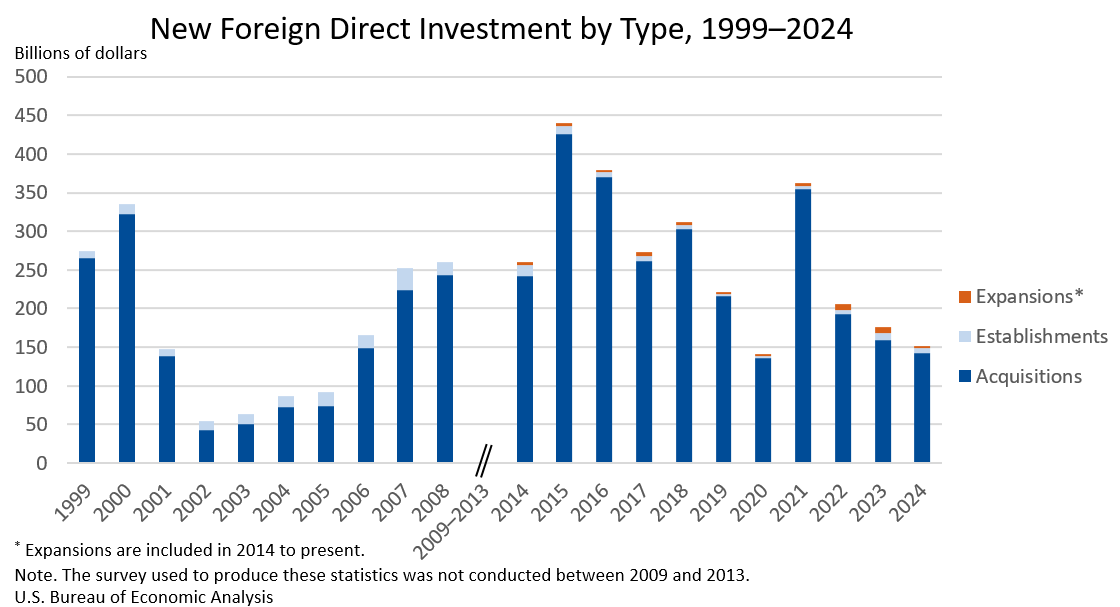Bureau of Economic Analysis
New Foreign Direct Investment in the United States, 2024
Expenditures by foreign direct investors to acquire, establish, or expand U.S. businesses totaled $151.0 billion in 2024, according to preliminary statistics released today by the U.S. Bureau of Economic Analysis. Expenditures decreased $24.9 billion, or 14.2 percent, from $176.0 billion (revised) in 2023 and were below the annual average of $277.2 billion for 2014–2023. As in previous years, acquisitions of existing U.S. businesses accounted for most of the expenditures.
Principal Federal Economic Indicators
Noteworthy
- 2025 News Release Schedule
- Innovation at BEA
- 2025 Annual Updates
- New! Services Trade Data for More Countries
- Data Tool: Trade in Value Added
- Distribution of State Personal Income
- Updated: RIMS II Regional Multipliers
- Arts and Culture
- Space Economy
- FDI Now in State BEARFACTS
- Quick Guide: Price Indexes
The Latest
State Quarterly Personal Income, 1st quarter 2014 - 4th quarter 2014; State Annual Personal Income, 2014 (preliminary estimates)
Average state personal income growth accelerated to 3.9 percent in 2014 from 2.0 percent in 2013, according to estimates released today by the U.S. Bureau of Economic Analysis. Growth of state personal income–the sum of net earnings by place of residence, property income, and personal current transfer receipts–ranged from 0.5 percent in Nebraska to 5.7 percent in Alaska and Oregon, with 45 states growing faster in 2014 than in 2013.
U.S. Current-Account Deficit Increases in Fourth Quarter 2014
The U.S. current-account deficit—a net measure of transactions between the United States and the rest of the world in goods, services, primary income (investment income and compensation), and secondary income (current transfers)—increased to $113.5 billion (preliminary) in the fourth quarter of 2014 from $98.9 billion (revised) in the third quarter of 2014. As a percentage of U.S. GDP, the deficit increased to 2.6 percent from 2.2 percent.…
U.S. International Transactions, 4th quarter and Year 2014
NOTE: See the navigation bar at the right side of the news release text forimportant note about the comprehensive restructuring of the International Economic Accounts. Also see--> links to data tables, contact personnel and their telephone numbers, and supplementary materials. -->
William Zeile: (202) 606-9893 (Data) Christopher Gohrband: (202) 606-9564 (Revisions)
Travel and Tourism Spending Accelerated in the Fourth Quarter of 2014
Real spending on travel and tourism accelerated in the fourth quarter of 2014, increasing at an annual rate of 4.5 percent after increasing 3.4 percent (revised) in the third quarter. By comparison, real gross domestic product (GDP) decelerated, increasing 2.2 percent (second estimate) in the fourth quarter after increasing 5.0 percent. For the year, real spending on travel and tourism increased 2.5 percent in 2014 after increasing 3.6…
Travel and Tourism Satellite Accounts, 4th quarter 2014
Real spending on travel and tourism accelerated in the fourth quarter of 2014, increasing at an annual rate of 4.5 percent after increasing 3.4 percent (revised) in the third quarter. By comparison, real gross domestic product (GDP) decelerated, increasing 2.2 percent (second estimate) in the fourth quarter after increasing 5.0 percent. For the year, real spending on travel and tourism increased 2.5 percent in 2014 after increasing 3.6…
BEA's Statistics on How Industries Perform Each Quarter Provide Insight into U.S.' Economic Recovery
Thanks to a new set of BEA data, you can now find out how the economic recovery that began in the summer of 2009 is affecting America’s industries each quarter.
Last spring, BEA for the first time began producing on a regular basisquarterly statistics that provide information on the amount of economic activity generated by individual industries, making it easy to spot when and how fast these industries began to recover.
January 2015 Trade Gap is $41.8 Billion
The U.S. monthly international trade deficit decreased in January 2015 according to the U.S. Bureau of Economic Analysis and the U.S. Census Bureau. The deficit decreased from $45.6 billion in December (revised) to $41.8 billion in January, as imports decreased more than exports. The previously published December deficit was $46.6 billion. The goods deficit decreased $3.4 billion from December to $61.6 billion in January. The services surplus…
U.S. International Trade in Goods and Services, January 2015
U.S. Census Bureau U.S. Bureau of Economic Analysis NEWS U.S. Department of Commerce * Washington, DC 20230 U.S. INTERNATIONAL TRADE IN GOODS AND SERVICES January 2015 The U.S. Census Bureau and the U.S.
Real Disposable Income Rises In January
Personal income rose 0.3 percent in January, the same increase as in December. Wages and salaries, the largest component of personal income, rose 0.6 percent in January after rising 0.1 percent in December.
Current-dollar disposable personal income (DPI), after-tax income, rose 0.4 percent in January after rising 0.3 percent in December.
Real DPI, income adjusted for taxes and inflation, increased 0.9 percent in…
Personal Income and Outlays, January 2015
Personal income increased $50.8 billion, or 0.3 percent, and disposable personal income (DPI) increased $52.6 billion, or 0.4 percent, in January, according to the Bureau of Economic Analysis. Personal consumption expenditures (PCE) decreased $18.9 billion, or 0.2 percent.




